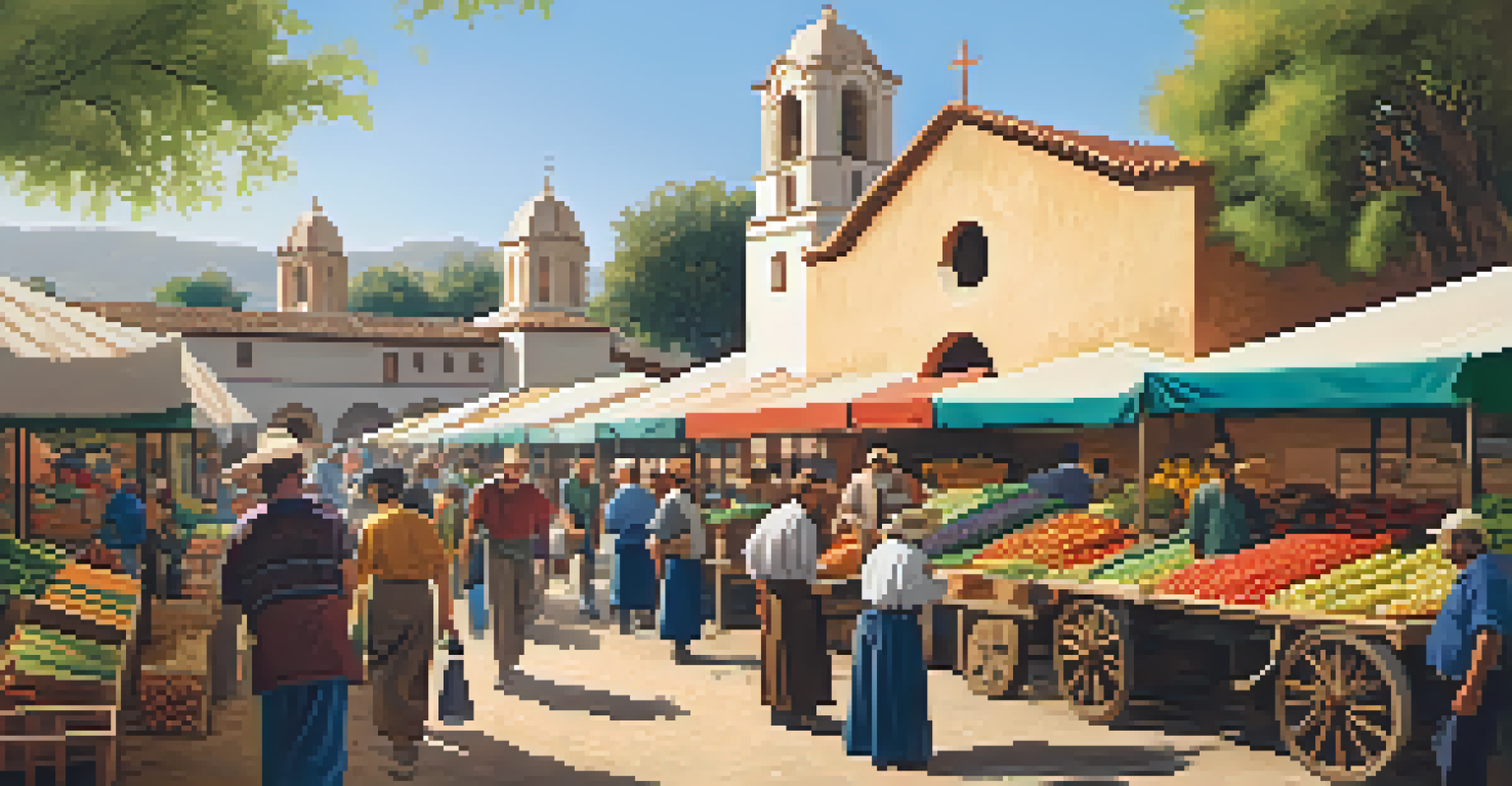Mission Era: Agriculture's Role in Early California Settlements

Introduction to the Mission Era in California
The Mission Era, spanning from the late 18th to mid-19th centuries, marked a transformative period in California's history. During this time, Spanish missionaries established a series of missions along the coast, aiming to spread Christianity and European culture to Indigenous peoples. These missions became more than just religious outposts; they were integral to the agricultural development of the region.
The land is the source of all life; the food we grow nourishes our bodies and our communities.
As settlers moved in, the missions developed into self-sustaining communities. This shift not only altered the landscape but also introduced new agricultural practices and crops. The integration of European farming techniques with Native American traditions created a unique agricultural framework that would shape California's economy.
Understanding the Mission Era is crucial to appreciating how agriculture laid the groundwork for modern California. This period was characterized by the establishment of farming as a vital part of daily life, fostering a connection between the land and its inhabitants that persists even today.
The Role of Agriculture in Mission Sustainability
Agriculture was the backbone of the missions, helping to sustain both the settlers and the Indigenous populations. Crops like wheat, barley, and corn were introduced, providing essential food sources. The missionaries cultivated these crops on vast tracts of land, relying on the labor of Native Americans, who often found themselves in a complex relationship with their new roles.

The mission gardens and orchards flourished, producing fruits like grapes, olives, and citrus. This agricultural bounty not only fed local communities but also laid the foundation for California's future as a leading agricultural state. The cultivation of these crops marked a significant shift from traditional Indigenous practices to European methods.
Agriculture Fueled Mission Growth
The Mission Era relied heavily on agriculture, transforming missions into self-sustaining communities that shaped California's economy.
Ultimately, the sustainability of the missions depended heavily on agriculture. The success of farming efforts allowed the missions to thrive, transforming them into centers of commerce and trade, which helped to integrate them further into the burgeoning Californian economy.
The Introduction of New Crops and Farming Techniques
One of the most significant impacts of the Mission Era was the introduction of new crops and farming techniques from Europe. Missionaries brought with them a wealth of agricultural knowledge and practices that changed the landscape of California. This exchange not only included crops but also livestock, such as cattle, sheep, and horses, which became essential for farming operations.
Agriculture is the most healthful, most useful, and most noble employment of man.
These new farming techniques included irrigation methods that improved crop yields and transformed arid landscapes into fertile fields. The missions became laboratories for experimenting with different agricultural practices, leading to the development of a diverse range of crops suited to California's unique climate. This experimentation laid the groundwork for California's agricultural innovation.
As these new crops and techniques took root, they began to shape the culinary landscape of the region. Foods like wine from grapes and olive oil from olives became staples in local diets, influencing California's cuisine and agricultural identity long after the Mission Era ended.
Impact on Indigenous Agricultural Practices
The arrival of missionaries had a profound impact on Indigenous agricultural practices. Many Native Americans were skilled farmers, but the introduction of European crops and farming methods changed their traditional ways of life. While some communities adapted to incorporate new crops, others struggled to maintain their original practices amidst the sweeping changes.
The relationship between the missionaries and Indigenous peoples was often complex and fraught with tension. While some missionaries aimed to educate and integrate Indigenous populations into agricultural practices, others imposed European methods without regard for existing systems. This sometimes led to the erosion of traditional knowledge and practices.
New Crops Changed Local Farming
European crops and farming techniques introduced during the Mission Era revolutionized Indigenous agricultural practices and diversified California's culinary landscape.
Despite these challenges, the blending of agricultural knowledge resulted in a rich tapestry of farming techniques. Indigenous peoples and missionaries collaborated in some instances, leading to hybrid farming practices that combined the best of both worlds, ensuring the survival of certain crops and traditions.
The Role of Livestock in Mission Settlements
Livestock played a crucial role in the agricultural success of mission settlements. Cattle, sheep, and goats provided not only meat and milk but also labor for plowing fields and transportation. The presence of these animals significantly enhanced the productivity of mission farms, allowing them to support larger populations.
Missionaries quickly recognized the value of livestock in sustaining their communities. They bred animals specifically for their needs, creating robust herds that became a source of wealth for the missions. This livestock industry contributed to the economic self-sufficiency of missions, enabling them to trade with surrounding settlements.
Moreover, the integration of livestock into mission agriculture had lasting effects on California's ranching culture. The practices established during the Mission Era laid the groundwork for what would become a thriving cattle industry, influencing California's identity as an agricultural powerhouse.
Trade and Economic Development Through Agriculture
As missions flourished, so did their agricultural output, leading to increased trade and economic development. The surplus of crops and livestock allowed missions to engage in barter and trade with neighboring communities and settlements. This exchange not only fostered economic growth but also established vital connections between different regions of California.
The agriculture-driven economy of the missions attracted settlers and entrepreneurs who sought new opportunities. Mission-produced goods, from grains to wines, began to circulate in broader markets, laying the foundation for California's future as a major agricultural hub. This trade network would evolve over the years, influencing the state's economic landscape.
Legacy of Mission Agricultural Practices
The agricultural innovations and practices established during the Mission Era continue to influence California's identity as a leading agricultural state today.
Ultimately, the agricultural practices established during the Mission Era set the stage for California's modern economy. By nurturing trade relationships and encouraging agricultural innovation, the missions contributed significantly to the state's development and prosperity.
Legacy of the Mission Era in California Agriculture
The legacy of the Mission Era is deeply ingrained in California's agricultural landscape today. The introduction of diverse crops and farming practices during this time laid the foundation for California's status as one of the leading agricultural states in the U.S. The influence of mission agriculture can still be seen in the cultivation of staple crops and the prevalence of certain farming techniques.
Additionally, many of the original mission sites have evolved into vibrant agricultural communities, preserving the historical significance of the era. These locations often celebrate their agricultural heritage through festivals and local markets, showcasing the enduring connection between history and modern farming.

In essence, the Mission Era not only shaped the agricultural practices of its time but also left a lasting impact on California's identity. Understanding this history is essential for appreciating the state's rich agricultural diversity and the cultural narratives that have emerged from it.